The skeletal system is the body’s framework‚ comprising 206 bones divided into axial and appendicular sections‚ providing essential support‚ protection‚ and facilitating movement and bodily functions.
1.1 Importance of the Skeletal System
The skeletal system is vital for providing structural support and protection to the body; It acts as a framework‚ enabling movement and maintaining posture. Bones protect internal organs‚ such as the brain‚ heart‚ and lungs‚ while also serving as a storage site for minerals like calcium and phosphorus. Additionally‚ the skeletal system produces blood cells in the bone marrow‚ essential for immune function and oxygen transport. Its role in facilitating movement through muscle attachment highlights its importance in mobility and overall bodily functions. Without the skeletal system‚ the body would lack shape‚ protection‚ and the ability to perform even the most basic movements. Its functions are integral to survival and daily activities.
1.2 Types of Skeletal Systems
The skeletal system varies significantly across different organisms‚ with distinct types serving specific functions. In humans and other vertebrates‚ the skeletal system is classified into two main divisions: the axial skeleton and the appendicular skeleton. The axial skeleton includes bones that form the central axis of the body‚ such as the skull‚ vertebral column‚ and ribcage‚ while the appendicular skeleton comprises the limbs and girdles. In contrast‚ invertebrates like insects and crustaceans have exoskeletons‚ rigid external structures that provide support and protection. Hydrostatic skeletons‚ found in organisms like earthworms‚ rely on fluid pressure for movement. Additionally‚ some animals‚ such as sharks‚ have cartilaginous skeletons‚ while others‚ like corals‚ have calcareous skeletons. Each type of skeletal system is adapted to the needs and environments of the organism‚ ensuring optimal functionality and survival. These variations highlight the diversity and adaptability of skeletal systems in the biological world.
Functions of the Skeletal System
The skeletal system provides structural support‚ protects vital organs‚ facilitates movement‚ stores minerals‚ and produces blood cells essential for overall health and bodily functions.
2.1 Support and Structure
The skeletal system acts as the body’s internal framework‚ providing support and maintaining posture. It consists of 206 bones‚ divided into the axial and appendicular skeleton. The axial skeleton includes the skull‚ vertebral column‚ and ribcage‚ forming the central axis of the body. The appendicular skeleton comprises the upper and lower limbs‚ shoulders‚ and pelvic girdles‚ which attach to the axial skeleton. Together‚ these bones create a sturdy structure that supports the body’s weight and facilitates movement. The skull protects the brain‚ while the ribcage safeguards vital organs like the heart and lungs. This system also serves as an attachment point for muscles‚ enabling bodily movements and maintaining overall structural integrity.
2.2 Protection of Internal Organs
The skeletal system plays a vital role in safeguarding internal organs from injury. The skull encases and protects the brain‚ while the vertebral column shields the spinal cord. The ribcage forms a protective barrier around the heart‚ lungs‚ and liver‚ ensuring these vital organs remain secure. This defensive function is crucial for maintaining the body’s integrity and preventing damage from external forces or trauma. By enclosing essential organs within bony structures‚ the skeletal system ensures their safety‚ allowing the body to function optimally without risking internal harm.
2.3 Movement and Mobility
The skeletal system enables movement by providing a framework for muscle attachment and leverage. Bones act as levers‚ while joints serve as pivot points‚ allowing for a wide range of motion. The axial skeleton supports the body’s posture and facilitates movements like twisting and bending‚ while the appendicular skeleton enables limb movement‚ such as walking‚ running‚ and grasping. The interaction between bones‚ joints‚ and muscles creates a sophisticated system for mobility‚ ensuring precise and coordinated movements. This functional integration allows humans to perform complex activities‚ from fine motor tasks to large-scale physical exertions‚ making the skeletal system indispensable for locomotion and overall mobility.
2.4 Blood Cell Production
The skeletal system plays a crucial role in blood cell production through the bone marrow‚ a spongy tissue within the cavities of bones. Hematopoiesis‚ the process of producing blood cells‚ occurs primarily in the marrow of the axial skeleton‚ such as the pelvis‚ vertebrae‚ and ribs. This process generates red blood cells‚ white blood cells‚ and platelets‚ essential for oxygen transport‚ immune defense‚ and blood clotting. The bone marrow’s unique environment supports the differentiation and maturation of stem cells into functional blood cells. This vital function underscores the skeletal system’s importance in maintaining overall health and bodily functions‚ making it indispensable for the production of circulating blood cells throughout life.
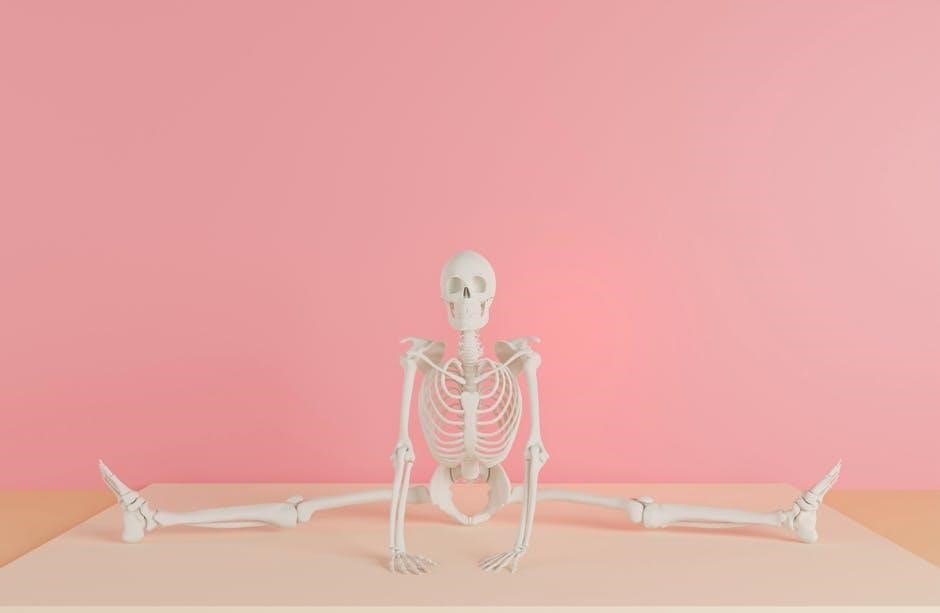
Structure of the Skeletal System
The skeletal system consists of 206 bones and connective tissues like cartilage‚ tendons‚ and ligaments‚ forming a framework that supports the body and facilitates movement.
3.1 Axial Skeleton
The axial skeleton forms the central framework of the body‚ comprising 80 bones. It includes the skull‚ vertebral column‚ and thoracic cage‚ which protect vital organs like the brain and internal organs such as the heart and lungs. The skull consists of the cranium and the facial bones‚ providing a protective casing for the brain. The vertebral column‚ made up of 33 vertebrae‚ supports the spinal cord and maintains posture. The thoracic cage‚ which includes the ribs and sternum‚ encloses and safeguards the chest cavity‚ housing essential organs like the heart and lungs. Together‚ these components provide structural support and protection for the body’s core systems‚ ensuring overall stability and functionality;
3.2 Appendicular Skeleton
The appendicular skeleton consists of 126 bones and includes the upper and lower limbs‚ as well as the pelvic and shoulder girdles. It provides a framework for movement and locomotion‚ connecting the limbs to the axial skeleton. The upper limb includes the humerus‚ radius‚ ulna‚ carpals‚ metacarpals‚ and phalanges‚ forming the arm‚ forearm‚ wrist‚ and hand. The lower limb comprises the pelvic girdle‚ femur‚ patella‚ tibia‚ fibula‚ tarsals‚ metatarsals‚ and phalanges‚ forming the hip‚ thigh‚ leg‚ ankle‚ and foot. This system facilitates a wide range of movements‚ enabling activities such as walking‚ running‚ and grasping‚ while also supporting the body’s weight and maintaining posture. Its structure allows for flexibility and strength‚ essential for daily functions and mobility.
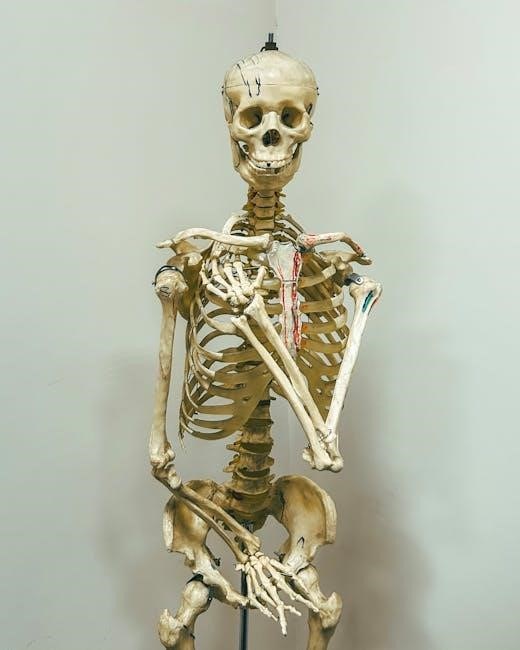
Bones: Composition and Types
Bones are composed of organic materials like collagen and inorganic minerals such as calcium‚ forming a strong yet flexible framework. They are classified into types based on shape and function.
4.1 Bone Composition
Bones are composed of both organic and inorganic materials. The organic component includes collagen‚ a flexible protein‚ while the inorganic part is primarily hydroxyapatite‚ a calcium-rich mineral. This combination provides bones with strength‚ rigidity‚ and flexibility. Bone tissue is dynamic‚ undergoing continuous remodeling through the action of osteoblasts and osteoclasts‚ which build and resorb bone‚ respectively. This process is essential for maintaining bone health and calcium balance. The density of bones peaks around age 30‚ after which it may gradually decline‚ leading to conditions like osteoporosis. Understanding bone composition is crucial for appreciating its role in overall health and mobility.
4.2 Classification of Bones
Bones are classified into five types based on their shapes and functions. Long bones‚ such as the femur and humerus‚ are cylindrical and provide structural support and facilitate movement. Short bones‚ like those in the wrist and ankle‚ are cube-shaped and provide stability. Flat bones‚ including the skull and ribs‚ offer protection for internal organs. Irregular bones‚ such as vertebrae and pelvic bones‚ have unique shapes tailored to specific roles. Lastly‚ sesamoid bones‚ like the patella‚ protect tendons and enhance muscle function. This classification reflects the diversity of bone structures‚ each adapted to perform distinct physiological roles within the skeletal system.

The Musculoskeletal System
The musculoskeletal system includes bones‚ muscles‚ tendons‚ and ligaments‚ working together to support the body‚ enable movement‚ and maintain posture and stability.
5.1 Interaction Between Muscles and Bones
The interaction between muscles and bones is fundamental for movement and stability. Muscles attach to bones via tendons‚ enabling movement through contraction and relaxation. This system allows precise control over body movements‚ from walking to fine motor tasks. Bones act as levers‚ while muscles provide the force necessary for motion. Ligaments connect bones to stabilize joints‚ ensuring proper alignment during movement. This integration is essential for maintaining posture‚ facilitating locomotion‚ and enabling the body to perform a wide range of activities. The musculoskeletal system’s efficiency relies on the coordinated interaction between these components‚ making it a vital aspect of human physiology and movement.
5.2 Role of Tendons and Ligaments
Tendons and ligaments are crucial connective tissues in the musculoskeletal system. Tendons attach muscles to bones‚ enabling muscle contractions to translate into movement. Ligaments connect bones to each other‚ stabilizing joints and preventing excessive movement. Together‚ they ensure efficient and controlled motion while protecting joints from damage. Tendons transmit forces from muscles to bones‚ facilitating actions like walking or lifting‚ while ligaments maintain joint integrity‚ preventing dislocation or instability. Both structures are essential for maintaining posture‚ enabling movement‚ and safeguarding the skeletal system from injury. Their coordinated function is vital for overall mobility and structural stability‚ making them indispensable components of the musculoskeletal system.
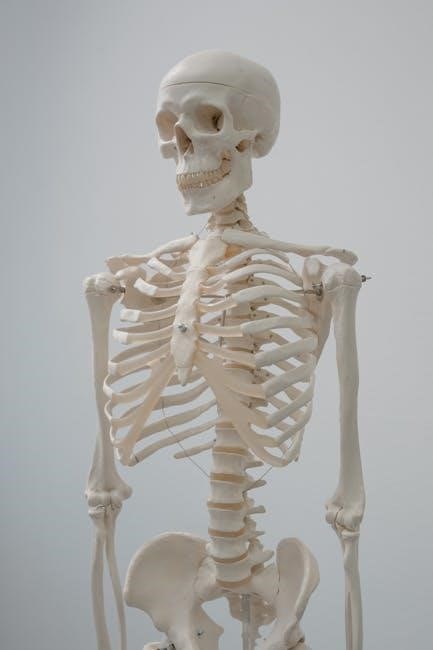
Growth and Development of the Skeleton
The skeleton grows and develops through childhood and adolescence‚ influenced by genetics‚ nutrition‚ and hormones. Bone density increases until around age 30‚ after which it may gradually decline.
6.1 Bone Growth and Development
Bone growth and development begin at birth‚ with the skeletal system starting with approximately 270 bones that gradually fuse‚ resulting in 206 bones in adulthood. This process‚ known as ossification‚ involves the replacement of cartilage with bone tissue. Growth plates‚ located in the bones of children and adolescents‚ are responsible for longitudinal growth. These plates gradually close as one matures‚ halting further growth. Factors such as genetics‚ hormones‚ and nutrition significantly influence bone development. Peak bone density is typically reached in early adulthood‚ around age 30‚ after which bone density may slowly decline. Understanding bone growth is essential for addressing conditions related to skeletal health and development.
6.2 Changes with Aging
Aging significantly impacts the skeletal system‚ leading to a gradual decline in bone density and strength. This natural deterioration increases the risk of fractures and conditions like osteoporosis. Bones become thinner and more brittle due to reduced calcium and vitamin D absorption‚ as well as hormonal changes. The joints also experience wear and tear‚ with cartilage losing elasticity and synovial fluid decreasing‚ leading to pain and stiffness. Additionally‚ spinal discs lose moisture‚ causing a decrease in height. Bone remodeling slows‚ with resorption outpacing formation‚ further weakening the skeleton. These changes can affect mobility‚ posture‚ and overall quality of life‚ emphasizing the importance of maintaining skeletal health through diet‚ exercise‚ and preventive care.
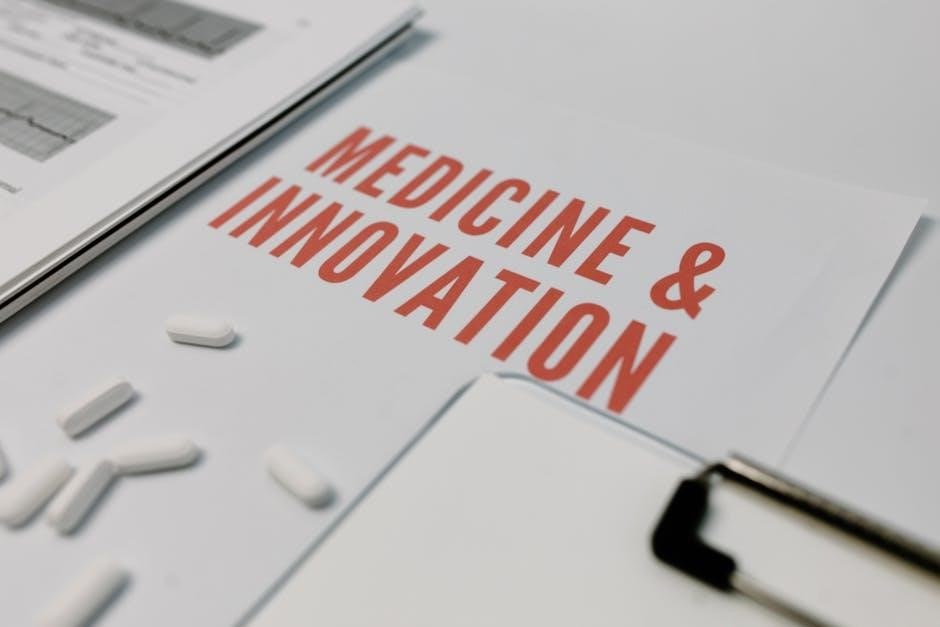
Common Injuries and Disorders
Common injuries include fractures‚ dislocations‚ and sprains‚ while disorders like osteoporosis and arthritis affect bone health‚ causing pain‚ fragility‚ and mobility issues in the skeletal system.
7.1 Fractures and Dislocations
A fracture refers to a break or crack in a bone‚ which can range from a small‚ hairline crack to a complete break. Fractures are often caused by injuries‚ falls‚ or sports accidents‚ and they can be classified into different types‚ such as transverse‚ oblique‚ or comminuted fractures; Dislocations‚ on the other hand‚ occur when a bone is forced out of its normal position in a joint‚ causing severe pain and limited mobility. Both fractures and dislocations require immediate medical attention to prevent further damage. Treatment may involve immobilization with casts or braces‚ physical therapy‚ or in severe cases‚ surgery to realign and stabilize the affected area. Proper care is essential to ensure complete healing and restore normal function to the skeletal system. Prevention strategies‚ such as strengthening bones and improving balance‚ can reduce the risk of these injuries.
7.2 Osteoporosis and Arthritis
Osteoporosis is a condition characterized by a loss of bone density‚ leading to brittle and fragile bones that are prone to fractures. It often results from hormonal changes or calcium and vitamin D deficiencies. Arthritis‚ on the other hand‚ refers to inflammation and degeneration of joints‚ causing pain‚ swelling‚ and stiffness. Common types include osteoarthritis (wear and tear of joint cartilage) and rheumatoid arthritis (an autoimmune disorder). Both conditions significantly impact mobility and quality of life. Early diagnosis and treatment‚ such as lifestyle modifications‚ medications‚ or physical therapy‚ can help manage symptoms and slow disease progression. Understanding these disorders is crucial for maintaining skeletal health and preventing long-term complications.
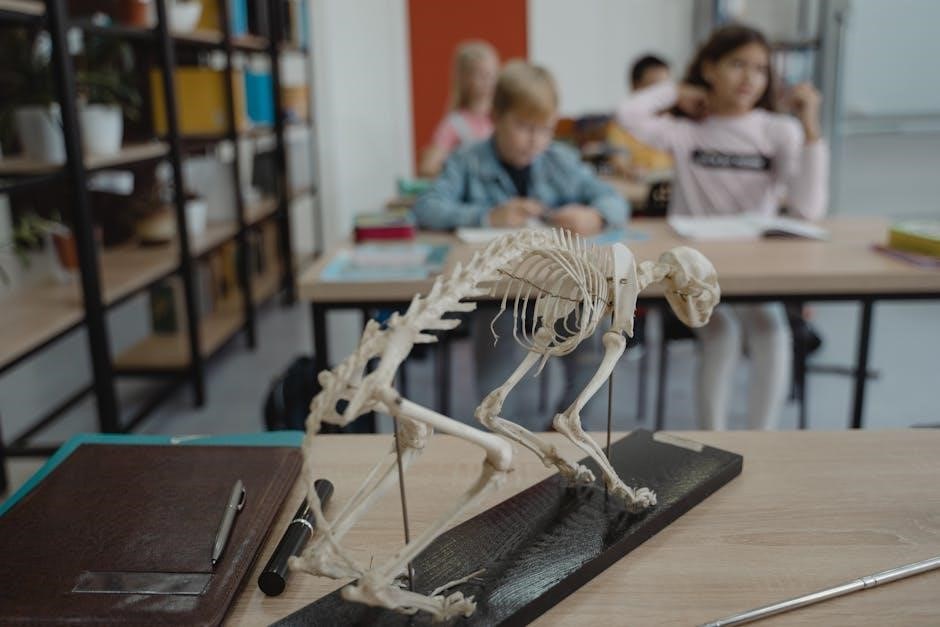
Educational Resources and PDFs
Free PDFs on the skeletal system provide detailed insights into bone structure‚ functions‚ and related disorders‚ offering valuable study materials for anatomy enthusiasts and students alike.
8.1 Recommended PDF Materials
Various PDF resources provide comprehensive insights into the skeletal system‚ including detailed anatomical illustrations and in-depth explanations of bone structures. One notable PDF outlines the axial and appendicular skeletons‚ highlighting their roles and compositions. Another document focuses on the musculoskeletal system‚ explaining the interaction between bones‚ muscles‚ tendons‚ and ligaments. Educational materials like “The Skeletal System” offer tutorials for students‚ covering bone functions‚ classifications‚ and common disorders. Additionally‚ downloadable guides provide step-by-step explanations of bone growth and development‚ as well as the effects of aging on the skeleton. These resources are invaluable for both learners and professionals seeking to understand the complexities of the human skeleton.
8.2 Online Tutorials and Guides
Online tutorials and guides offer interactive and engaging ways to learn about the skeletal system. Many resources provide step-by-step explanations‚ 3D models‚ and quizzes to enhance understanding. For example‚ tutorials introduce the skeletal system’s functions‚ bone classifications‚ and muscle-bone interactions. Some guides focus on specific topics like fractures‚ osteoporosis‚ and joint anatomy‚ making complex concepts accessible. Interactive modules allow users to explore the skeleton virtually‚ labeling bones and identifying their roles. Video tutorials complement textual information‚ offering visual demonstrations of bone structure and movement. These resources cater to diverse learning styles‚ making them ideal for students‚ educators‚ and professionals seeking to deepen their knowledge of the skeletal system.
